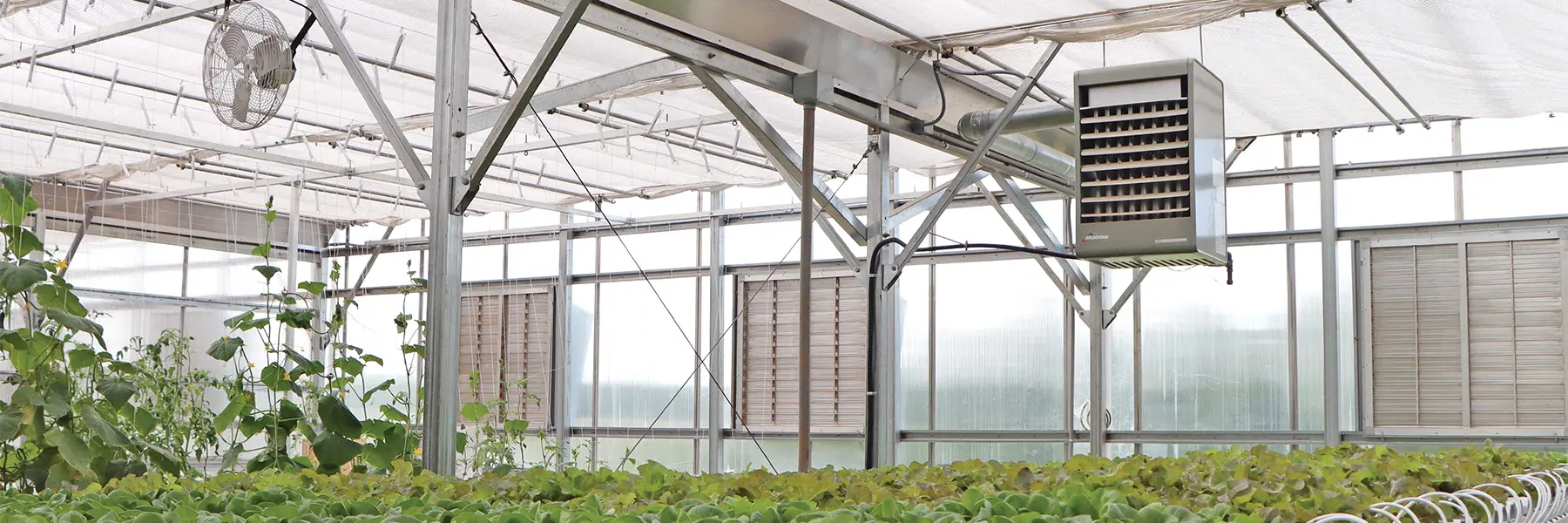How to Size a Greenhouse Heating System
Properly sizing a greenhouse heating system is crucial for increasing heating capacity and maintaining the perfect temperatures year-round. Sizing a greenhouse heating system only requires growers to make several measurements and a few calculations. Once the numbers are crunched, growers will be well on their way to sufficiently heating their operation.
Efficiency ratings are of utmost importance in greenhouse temperature control, whether it’s for an indoor heater, a heat pump or an air conditioner. An efficient, properly sized greenhouse heater delivers uniform heating to the plant canopy. This consistency in temperature promotes strong, rapid plant growth.
Heating system manufacturers have put special emphasis on heating efficiency in recent years, so that growers can more easily find a high-efficiency unit. GrowSpan offers the Modine Effinity 93 Condensing Unit Heater.
This heater is 93 percent efficient, making it one of the most energy-efficient heaters available to growers. High-efficiency models like this allow operations to save considerably on heating costs and reduce their carbon footprint.
Sizing a Greenhouse Heating System
Heaters are measured by their output in BTUH (British Thermal Units per Hour) as opposed to their physical size. A heater that is larger in size does not automatically mean more heat output. BTUH reflects the size of an area that a heater can keep warm each hour, and growers have to find a heater that can provide the right BTU per square foot ratio.
This ratio will help growers keep their greenhouse within an optimal temperature range for the specific crops they are producing. For example, an operation that’s primarily growing tomatoes will want to choose a heater that easily maintains temperatures between 60 and 80 degrees Fahrenheit.
To determine the appropriate heater size, growers can follow this step by step guide to calculate the amount of BTUH a heater needs to generate for their greenhouse. As an example, this guide will use a GrowSpan Series 2000 Commercial Greenhouse that measures 35 ft wide by 96 ft long.
Calculate the total surface area
First measure the end wall: 35 ft width x 14 ft (average wall height) = 490 (one end)
490 x 2 = 980 sq ft (both ends)
Next, measure the roof and multiply the length. Each side of the roof measures: 18’ x 96’ = 1,728
1,728 x 2 = 3,456 sq ft total roof surface area
Multiply the square feet by the U-factor
GrowSpan’s S2000 Greenhouse is covered with 8 mm polycarbonate, which has a U-factor of .62
490 (one end wall) x .62 = 304
3,456 (roof surface area) x .62 = 2,143
Add the numbers
304 + 2,142 = 2,447
Multiply by Delta T (the amount of heat loss over the length of the house.) We will use the highest Delta T number of 70 to ensure maximum heat capability.
2,447 x 70 = 171,290
Calculate the amount of BTUH
With GrowSpan’s 93% efficiency heater: 171,290 divided by .93 = 184,183. This number equates to how many BTUH are needed to heat the GrowSpan S2000 Greenhouse.
For more detailed information on heat-retaining ability, look over the chart that compares the R-value and U-value of different types of polycarbonate covering. R-Value is a measurement of the insulating ability of a given material. A higher R-Value means better insulation and helps growers avoid having a poorly insulated structure.
U-Value is the measurement of heat loss. As such, the lower the U-Value, the less heat that escapes and the easier it is to maintain a desired temperature.
| R-value (insulation) | U-factor (heat loss) | ||
| Poly Film | .83 | Poly Film | 1.20 |
| Double Layer Poly Film | 1.5 | Double Layer Poly Film | 0.66 |
| 8mm Twin Wall Polycarb | 1.72 | 8mm Twin Wall Polycarb | .62 |
As is evidenced by the numbers, a high-efficiency heater means a higher return on investment. A number of growers have been able to make their money back within the first two years of operating with a new heating system. Some operations may even qualify for utility rebates, depending on the region they live in.
GrowSpan’s Greenhouse Specialists can help accurately design effective heating systems for any growing operation. They can also help sync heating systems with greenhouse climate controllers for optimal performance and automation.
To ask a Greenhouse Specialist about designing your structure’s heating system, call or Request a Quote today.

